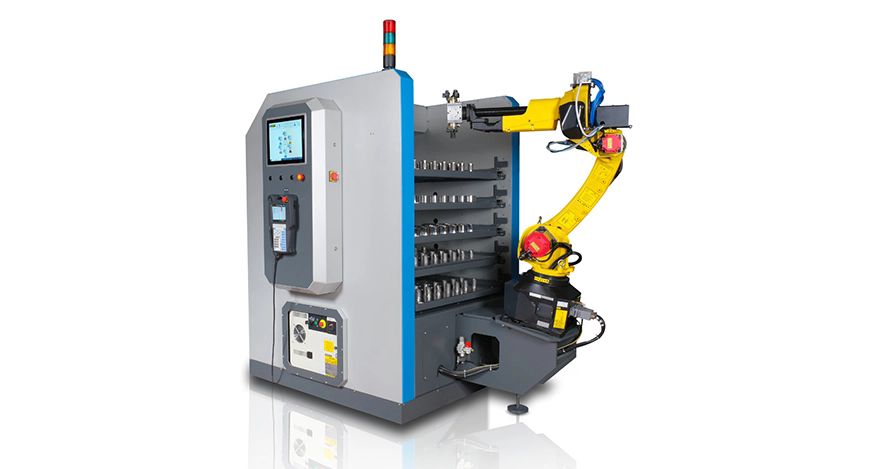 Cubebox Blues DR
Cubebox Blues DRHigh-mix, low-volume (HMLV) manufacturing presents unique challenges for machine shops, such as the frequent need to switch between different jobs, materials and machining processes. Yet, a key limitation of traditional CNC machining is the significant time lost to tool changes. How can manufacturers overcome the delays and inefficiencies of stopping production to load new tools?
Hakan Aydogdu, CEO of CNC automation system manufacturer
Tezmaksan Robot Technologies, said: “For manufacturers working in precision-driven sectors such as aerospace and medical devices, inefficiencies stemming from downtime are especially problematic. Production often involves complex geometries, tight tolerances and a wide variety of cutting tools. If a CNC machine is unable to accommodate all the tools required within a single setup, the process becomes more time-consuming, and the risk of errors increases.”
According to
Forbes, the average manufacturer experiences approximately 800hr of equipment downtime annually, equivalent to over 15hr per week, which results in significant unplanned costs. For example, in the automotive industry, a halted production line can cost manufacturers an estimated $22,000 per min.
With this in mind, the cost implications for HMLV production — characterised by shorter runs, more customisation and more frequent design changes — are significant. Unlike high-volume production, where a single setup can run for extended periods, HMLV requires agility — machines must be able to switch between different tasks with minimal downtime.
Changing market trendsMr Aydogdu continued: “This frequent transitioning can lead to increased per-unit cost due to reduced economies of scale. In a review published in
Applied Sciences, changing market trends has created demands for product differentiation and personalisation. This trend shifts manufacturing from high-volume, low-mix production to HMLV. To address this, manufacturers need to find new ways to minimise tool related downtime — and one solution is to increase CNC machine tool capacity, supported by automatic tool changers (ATCs) that support fast, seamless switching between tools without manual intervention.”
Automation plays a crucial role in making high-mix production more efficient. CNC systems with large tool capacities, which means they can handle 200 or more tools, offer a significant advantage to machine shops that are seeking to diversify. By reducing the need for manual intervention, ATCs allow manufacturers to maintain continuous operation, improve machining accuracy and increase overall efficiency. Furthermore, they can work around the clock, reducing reliance on operators and improving consistency. This is especially important for manufacturers facing labour shortages or those aiming to maximise efficiency in lights-out manufacturing.
In fact, recent market research carried out by
DataIntelo confirms that demand for ATCs is growing steadily across sectors, driven by the need for faster changeovers and greater flexibility in automated production. The global ATCs market was valued at approximately $980 million in 2023, and is projected to nearly double, reaching around $1,900 million by 2032.
Mr Aydogdu added: “Beyond tool capacity, automation solutions like robotic loading systems, automatic tool changers and real-time monitoring can further improve CNC machining performance. Systems that integrate these technologies allow manufacturers to set up jobs faster, reduce cycle times and optimise tool life. For example, automation solutions that combine large tool capacities with predictive maintenance capabilities can extend tool longevity by monitoring wear and tear in real time. Instead of stopping production unexpectedly due to tool failure, manufacturers can schedule maintenance proactively, ensuring consistent output quality.”
He explained: “Manufacturers must tackle the challenges of HMLV production without sacrificing precision. This is particularly the case when manufacturing products where safety and quality are non-negotiable — such as in the medical devices industry. Products like orthopaedic implants and surgical instruments must meet strict regulatory standards and undergo thorough quality control. Manufacturers must comply with ISO:13485, a globally recognised quality management system that enforces strict controls over production processes, material traceability and risk management.”
Complex machining operations in one setupTo this end, CNC machines with large tool capacities are an asset because they allow manufacturers to complete complex machining operations in one setup. This minimises the number of times a part must be repositioned or re-clamped, which can introduce inaccuracies.
Mr Aydogdu said: “What is more, the ability to accommodate a wide range of tools assists manufacturers in producing intricate, custom components more efficiently. In the medical sector, where patient-specific implants and prosthetics are becoming more common, this flexibility is crucial. CNC automation solutions like Tezmaksan’s CubeBOX systems enable continuous, operator-free CNC machine tending. Designed to integrate seamlessly with various machining centres and lathes, CubeBOX automates loading and unloading tasks, reducing downtime and increasing overall productivity.”
CubeBOX Blues DR MAX, for example, features a flexible drawer stacker system that accommodates a wide range of workpiece sizes. Its integration with Tezmaksan’s RoboCAM+ software allows for quick and intuitive programming, eliminating the need for advanced robotics expertise. With the ability to support single, double or multiple machine applications, CubeBOX Blues DR MAX enhances operational efficiency by reducing downtime, minimising manual intervention and enabling continuous, operator-free machining — making it an asset for manufacturers in various industries.
Mr Aydogdu concluded: “As manufacturing continues to evolve, the demand for greater efficiency, precision and flexibility will only increase. CNC systems with large tool capacities provide a scalable solution for manufacturers looking to improve productivity, precision and competitiveness in HMLV production runs — without compromising quality.”
Tezmaksan Robot Technologies, based in Turkey, is a prominent European CNC machine manufacturer specialising in robotic automation solutions. Established in 2009 by Tezmaksan Makine (founded in 1981), the company focuses on developing cost-efficient and highly profitable turnkey automation solutions, including robotic automation and robotic line installation. Its CubeBOX systems are notable for their user-friendly RoboCAM software, which simplifies robot programming.
Kenilworth-based
Whitehouse Machine Tools (WMT) offers Tezmaksan's CubeBOX range of robotic cells to the UK and Ireland markets. Established in 1983, the company has built a reputation as a leader in high-quality CNC milling and turning machine solutions.